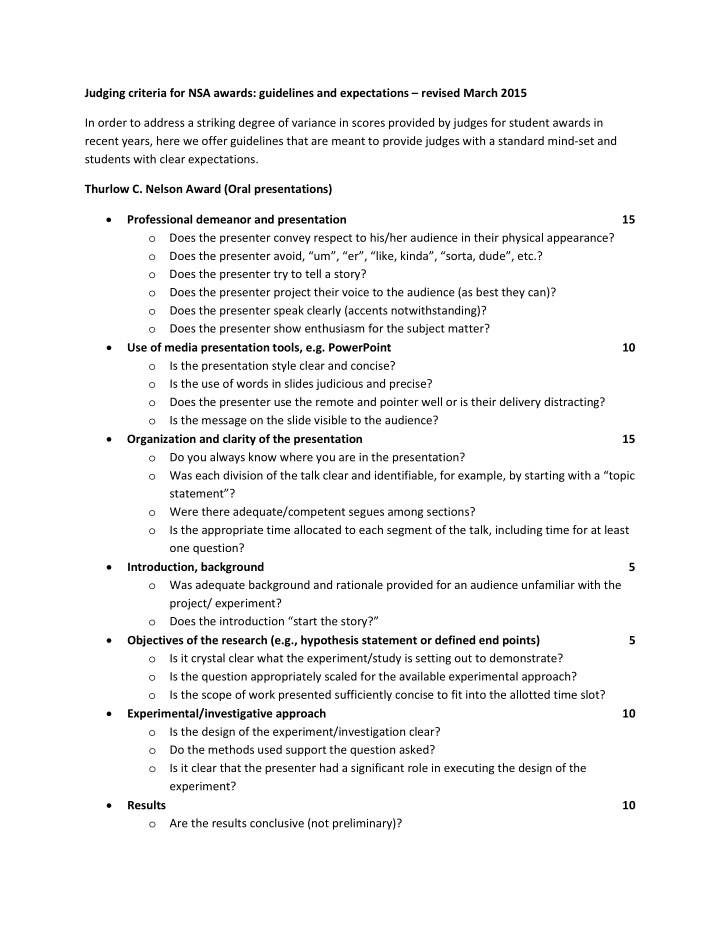



Judging criteria for NSA awards: guidelines and expectations – revised March 2015 In order to address a striking degree of variance in scores provided by judges for student awards in recent years, here we offer guidelines that are meant to provide judges with a standard mind-set and students with clear expectations. Thurlow C. Nelson Award (Oral presentations) • Professional demeanor and presentation 15 o Does the presenter convey respect to his/her audience in their physical appearance? o Does the presenter avoid, “um”, “er”, “like, kinda”, “sorta, dude”, etc.? o Does the presenter try to tell a story? o Does the presenter project their voice to the audience (as best they can)? o Does the presenter speak clearly (accents notwithstanding)? o Does the presenter show enthusiasm for the subject matter? • Use of media presentation tools, e.g. PowerPoint 10 o Is the presentation style clear and concise? o Is the use of words in slides judicious and precise? o Does the presenter use the remote and pointer well or is their delivery distracting? o Is the message on the slide visible to the audience? • Organization and clarity of the presentation 15 o Do you always know where you are in the presentation? o Was each division of the talk clear and identifiable, for example, by starting with a “topic statement”? o Were there adequate/competent segues among sections? o Is the appropriate time allocated to each segment of the talk, including time for at least one question? • Introduction, background 5 o Was adequate background and rationale provided for an audience unfamiliar with the project/ experiment? o Does the introduction “start the story?” • Objectives of the research (e.g., hypothesis statement or defined end points) 5 o Is it crystal clear what the experiment/study is setting out to demonstrate? o Is the question appropriately scaled for the available experimental approach? o Is the scope of work presented sufficiently concise to fit into the allotted time slot? • Experimental/investigative approach 10 o Is the design of the experiment/investigation clear? o Do the methods used support the question asked? o Is it clear that the presenter had a significant role in executing the design of the experiment? • Results 10 o Are the results conclusive (not preliminary)?
Judging criteria, page 2 o Was sufficient evidence presented to answer the objectives of the research? o Were the data statistically analyzed, where appropriate? o Do the statistical findings support the conclusions made? • Discussion and conclusions 10 o Were alternative interpretations presented? o Was the work placed in context of other related science, i.e., what have others done? o Were inconsistencies in data, if any, addressed? o Were limitations of conclusions adequately acknowledged? o Was the “bottom line” of the project succinctly presented? o Was the take-away message clear in the final analysis? o Did the presenter avoid meaningless generalizations? • Creativity and originality 10 o Is there a creative edge to the presentation that makes it stand out above others? o Is the research question original, stemming from a novel idea? o Will the work make an impact on the field, either practical or academic? • Subject knowledge and question responses 10 o During the presentation, was it clear that the presenter was adequately familiar with the background material and rationale for the work? o Did the presenter leave enough time for questions (minimum 2 minutes)? o Were the presenter’s responses to questions coherent and appropriate? Gunter Award (Poster presentations) • Title 5 o Does the title pose, or promise an answer to, a decisive question? o Is the title understandable to someone in another discipline? • Presentation style (design, visual impact) 15 o Is space used judiciously? o Are the font style and size easily readable from a distance of 3-5 feet? o Is the style professionally rendered? o Is there an aesthetic quality to colors and styles used? • Presentation organization & clarity 15 o Can the reader easily navigate the various sections in sequence? • Introduction (clear and succinct) 10 o Was adequate background and rationale provided for an audience unfamiliar with the project/ experiment? o Does the introduction “start the story?” • Objectives of the research (e.g., hypothesis statement or defined end points) 10 o Is it crystal clear what the experiment is setting out to demonstrate?
Judging criteria, page 3 o Is the question appropriately scaled for the available experimental approach? • Experimental approach 10 o Is the design of the experiment or investigation clear? o Do the methods used support the question asked? o Is it clear that the presenter had a significant role in executing the design of the experiment? • Results 10 o Are the results conclusive (not preliminary)? o Was sufficient evidence presented to answer the objectives of the research? o Were the data statistically analyzed? o Do the statistical findings support the conclusions made? • Discussion and conclusions 10 o Were alternative interpretations presented? o Was the work placed in context of other related science, i.e., what have others done? o Were inconsistencies in data, if any, addressed? o Were limitations of conclusions adequately acknowledged? o Was the “bottom line” of the project succinctly presented? o Was the take-away message clear in the final analysis? o Did the presenter avoid meaningless generalizations? • Creativity and originality 10 o Is there a creative edge to the presentation that makes it stand out above others? o Is the research question original, stemming from a novel notion? • Overall impact 5 o Are the presentation and content sufficient to adequately convey the science and the message without additional input from the presenter/author?
Recommend
More recommend